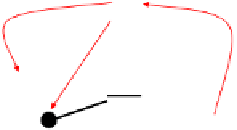Information Technology Reference
In-Depth Information
joins and forks can be freely combined and a fork does not need to be followed
by a join.
UCM models can be decomposed using
stubs
which contain sub-maps called
plug-ins
. Plug-in maps are reusable units of behavior and structure.
Plug-in
bindings
connect in-paths and out-paths of stubs with start and end points of a
plug-in map, respectively (see Fig. 2a for an example; note that the arrows have
been added to this and following figures to clearly indicate plug-in bindings for
the UCM model — UCM editing tools do not display such arrows but manage
plug-in bindings much more concisely). Stubs without plug-in bindings for start
or end points can be shown visually without an in-path or out-path, respectively
(see Fig. 2b). A stub may be
static
which means that it can have at most one
plug-in, whereas a
dynamic
stub may have many plug-ins which may be selected
at runtime. A
selection policy
decides which plug-ins of a dynamic stub to choose
at runtime.
Map elements which reside inside a component are said to be
bound
to the
component. Components have various types and characteristics (not discussed
in this paper) and can contain sub-components.
Other notational elements of UCMs are
timers
and
waiting places
.Atimer
may have a
timeout path
which is indicated by a zigzag line. A waiting place
denotes a location on the path where the scenario stops until a condition is
satisfied. If an endpoint is connected to a waiting place or a timer, the stopped
scenario continues when this end point is reached (synchronous interaction).
Asynchronous, in-passing triggering of waiting places and timers is also possible.
End points can also be connected to start points as shown in Fig. 2c to indicate
simple sequences of paths. A more complete coverage of the notation elements
is available in [17, 19, 38].
s1
e1
s1
e2
e1
e2
s2
s3
e3
s1
s2
e1
e4
s4
a) plug-in bindings
b) no in-path or out-path
c) connected paths
Fig. 2.
Connecting stubs, plug-in maps, and paths
UCMs also support the definition of scenarios. For each choice point in the
UCM model (e.g., an OR-fork), Boolean expressions are defined for all alterna-
tives. A scenario describes a specific path through the UCM model (only one
alternative at a choice point is taken) by initializing the variables used in the
Boolean expressions. For each scenario, its pre-conditions and post-conditions
are additionally specified as well as its start points and expected end points.
UCMs share many characteristics with UML activity diagrams but UCMs
offer more flexibility in how sub-diagrams can be connected, how sub-components

















Search WWH ::

Custom Search